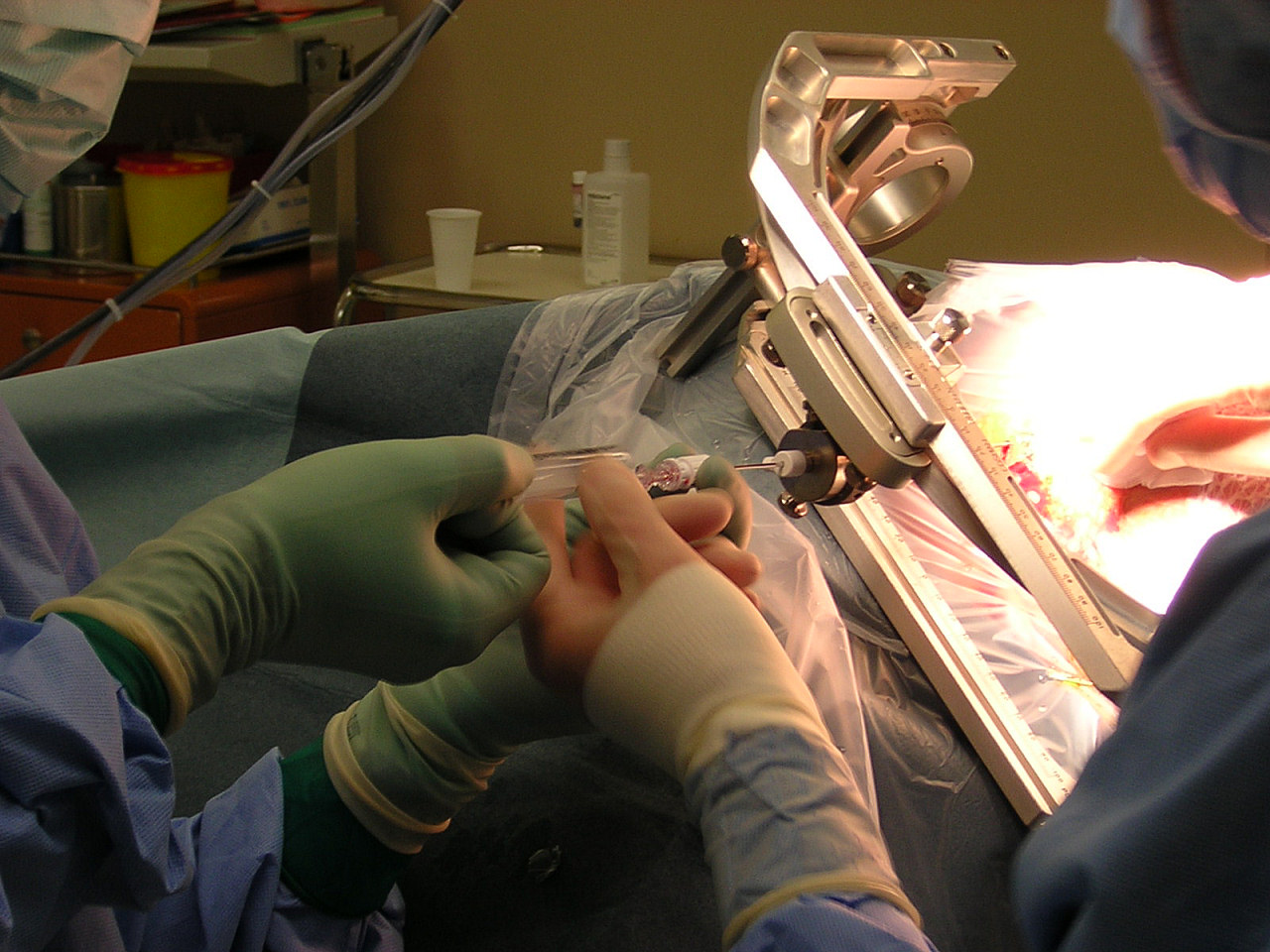Chondrosarcoma diagnostic study of choice: Difference between revisions
Jump to navigation
Jump to search
No edit summary |
No edit summary |
||
| Line 23: | Line 23: | ||
===Open Technique=== | ===Open Technique=== | ||
*The tumor is surgically exposed and biospy of the tumor is taken. | *The tumor is surgically exposed and biospy of the tumor is taken. | ||
{| align="right" | |||
| | |||
[[File:Biopsy.jpg|300px|thumb| Open Biopsy.[https://commons.wikimedia.org/wiki/File:Brain_biopsy_under_stereotaxy.jpg Source: Case courtesy of Dake~commonswiki, via Wikimedia Commons]]] | |||
|} | |||
===Types=== | ===Types=== | ||
===Incisional biopsy=== | ===Incisional biopsy=== | ||
| Line 57: | Line 60: | ||
*It is the most commonly used for carcinoma. | *It is the most commonly used for carcinoma. | ||
*It is usually not preferred for sarcoma | *It is usually not preferred for sarcoma | ||
{| align="right" | |||
| | |||
[[File:Needle biopsy.jpg|300px|thumb| Needle Biopsy.[https://upload.wikimedia.org/wikipedia/commons/0/02/Needle_biopsy.jpg Source: Case courtesy of Linda Bartlett (photographer) [Public domain], via Wikimedia Commons]]] | |||
|} | |||
===Core biopsy (Tru-cut Biopsy)=== | ===Core biopsy (Tru-cut Biopsy)=== | ||
*It allows for tumor structural examination. | *It allows for tumor structural examination. | ||
*It allows evaluation of both the cytologic and stromal elements of the tumor. | *It allows evaluation of both the cytologic and stromal elements of the tumor. | ||
*It is frequently used for sarcoma. | |||
===== Sequence of Diagnostic Studies ===== | ===== Sequence of Diagnostic Studies ===== | ||
Revision as of 16:57, 23 January 2019
|
Chondrosarcoma Microchapters |
|
Diagnosis |
|---|
|
Treatment |
|
Case Studies |
|
Chondrosarcoma diagnostic study of choice On the Web |
|
American Roentgen Ray Society Images of Chondrosarcoma diagnostic study of choice |
|
Risk calculators and risk factors for Chondrosarcoma diagnostic study of choice |
Editor-In-Chief: C. Michael Gibson, M.S., M.D. [1]; Associate Editor(s)-in-Chief: Rohan A. Bhimani, M.B.B.S., D.N.B., M.Ch.[2]
Overview
Biopsy is the gold standard test for the diagnosis of chondrosarcoma. Open biopsy is carried out for chondrosarcoma. The tumor is then staged based on Enneking system for chondrosarcoma.
Diagnostic Study of Choice
Study of choice
Prerequisites for a Biopsy
- CBC, platelets and coagulation studies
- Cross-sectional imaging to evaluate local anatomy such CT scan and MRI.
- Treatment center carrying out biopsy must be capable of proper diagnosis and treatment.
- The surgeon who performs biopsy should preferably be the one who is later going to do the final excision.
Technique
- Open
- Closed
Open Technique
- The tumor is surgically exposed and biospy of the tumor is taken.
 |
Types
Incisional biopsy
- A small surgical incision carefully placed to access tumor without contamination of critical structures
Excisional biopsy
- it is done for small, superficial soft tissue masses.
Incision
- Longitudinal incision in the extremities is taken.
- It should allow for extension of the incision for definitive management
Approach
- Never expose neurovascular structures.
- During the biopsy, all tissue exposed is considered contaminated with tumor.
- Meticulous hemostasis to be carried out.
- Post-surgery hematomas are considered contaminated with tumor.
- Always deflate the tourniquet prior to wound closure.
Biopsy
- Perform through the involved compartment of the tumor.
- For bone lesions with a soft tissue mass, perform the biopsy using the soft tissue mass.
'Closure
- If drain is kept, remove the drain out of the skin in line with surgical incision.
- This helps in excising the drain site with definitive surgical extensile incision.
Closed Technique
Types
Fine Needle Aspiration (FNA)
- It provides cytologic specimen.
- It is the most commonly used for carcinoma.
- It is usually not preferred for sarcoma
 |
Core biopsy (Tru-cut Biopsy)
- It allows for tumor structural examination.
- It allows evaluation of both the cytologic and stromal elements of the tumor.
- It is frequently used for sarcoma.
Sequence of Diagnostic Studies
The various investigations must be performed in the following order:
- X-ray
- MRI
- Biopsy
Staging
Enneking (MSTS) Staging System
- The Enneking surgical staging system (also known as the MSTS system) for malignant musculoskeletal tumors based on histological and radiographic characteristics of the tumor host margin.[3][4]
- It is widely accepted and routinely used staging system.
| Stages | Grade | Site | Metastasis |
|---|---|---|---|
| IA | G1: Low grade | T1: Intracompartmental | M0: No metastasis |
| IB | G1: Low grade | T2: Extracompartmental | M0: No metastasis |
| IIA | G2: High grade | T1: Intracompartmental | M0: No metastasis |
| IIB | G2: High grade | T2: Extracompartmental | M0: No metastasis |
| III | G1 or G2 | T1 or T2 | M1: Regional or distant metastasis |
References
- ↑ Peabody, Terrance (2014). Orthopaedic oncology : primary and metastatic tumors of the skeletal system. Cham: Springer. ISBN 9783319073224.
- ↑ Czerniak, Bogdan (2016). Dorfman and Czerniak's bone tumors. Philadelphia, PA: Elsevier/Saunders. ISBN 9780323023962.
- ↑ Jawad MU, Scully SP (2010). "In brief: classifications in brief: enneking classification: benign and malignant tumors of the musculoskeletal system". Clin Orthop Relat Res. 468 (7): 2000–2. doi:10.1007/s11999-010-1315-7. PMC 2882012. PMID 20333492.
- ↑ Peabody, Terrance (2014). Orthopaedic oncology : primary and metastatic tumors of the skeletal system. Cham: Springer. ISBN 9783319073224.